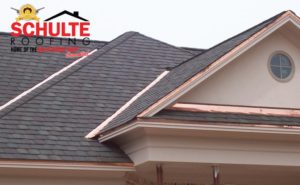Asphalt roof shingles are the most common type of roofing materials used in the United States . Compared to other materials, asphalt maintains a good balance between cost and durability which is why it is so popular. Before deciding on this type of material, keep in mind that it has many varieties in terms of design, thickness, and size as well as the type of material used to reinforce it. These subtle differences can significantly affect its longevity and durability.
. Compared to other materials, asphalt maintains a good balance between cost and durability which is why it is so popular. Before deciding on this type of material, keep in mind that it has many varieties in terms of design, thickness, and size as well as the type of material used to reinforce it. These subtle differences can significantly affect its longevity and durability.
Types of Asphalt Shingles
- Strip – This is the most common design pattern of asphalt shingles. Each rectangular strip has three cutouts that run up to the center forming three individual tabs on one sheet. The cutout is nothing more than a design to make the strip look like three individual shingles instead of just one. The portion that joins the three tabs is overlaid by another strip to make it invisible. The advantage of such design is that the tabs create the illusion of having three separate shingles. The result is a considerably stronger material that requires less nailing because of the portion that joins the three tabs.
- Interlocking – An interlocking shingle is one that comes with a protrusion on each individual panel. The idea of using the protrusion is that each panel is able to interlock with the next one, creating additional support. This design is particularly useful in locations that often experience strong gusts of wind. The interlocking mechanism serves with the fastener as dual protection to keep the material from loosening and breaking.
- Large Individual – Unlike the strip design, the large individual type does not have tabs. It is one solid slab that consists of asphalt and composition material; this material is known for its durability and its considerable weight. From a distance, the thickness of the shingle creates a more textured character on the roof.
- Laminated – In specialty applications, when an architect chooses a particular design to match the structure and characteristic of the building, laminated shingles are often used. These can be ordered in various shapes, sizes and thickness making it easy for architects to match a particular building design.
Organic vs. Fiberglass Composition
While asphalt is the main ingredient for shingles, it is brittle on its own and can easily break. In order to keep it solid enough to tackle extreme weather conditions, it must have a reinforcing material mixed with it. Asphalt shingles come with two types or reinforcement: organic and fiberglass.
- Organic Composition – Organic composition is usually recyclable organic material such as wood shavings from mills as well as cardboard and paper. These are mixed with the asphalt to improve its structural integrity. Due to the nature of organic materials, shingles with organic composition do not last very long, particularly in locations with frequent snow and rain. It also is a poor fire retardant.
- Fiberglass Composition – Many expensive asphalt shingles are mixed with fiberglass matting to prevent them from breaking during heavy winds. The cost is high due to the expensive price of the fiberglass; yet it is a good tradeoff because the lifespan is longer than those with organic composition; it is also a good fire retardant.
One of the factors that speed up asphalt deterioration is heat. Hot temperatures can easily bake the asphalt, turning it dry and brittle. To prevent early deterioration, it is best to choose a thick type of shingle with embedded minerals to protect it from UV rays.
Hopefully the above tips will assist in making a decision regarding asphalt shingles and the resulting choice will be the best for the roof and the climate!
Do you need to find a Brazos Valley or Houston roof company that can install asphalt shingles? The team of experts at Schulte Roofing can help in the initial material selection as well as install that chosen material in the best way possible!
